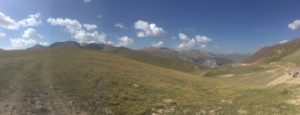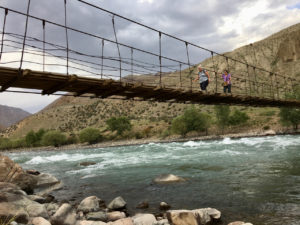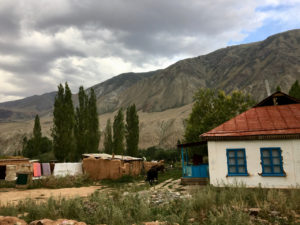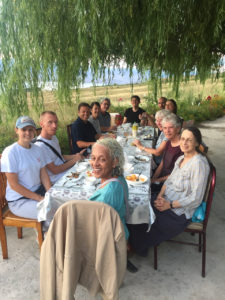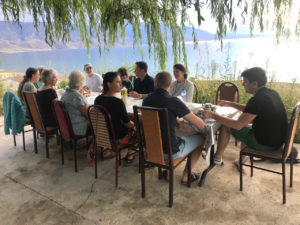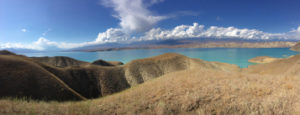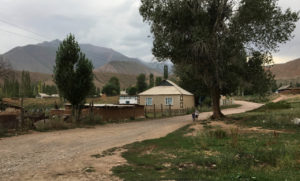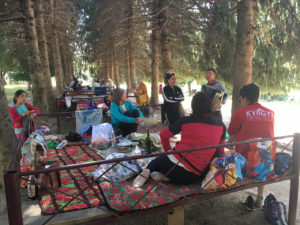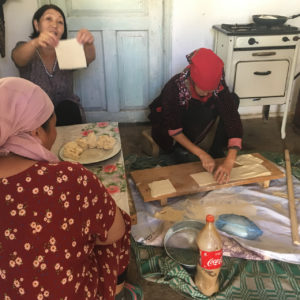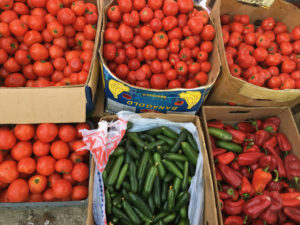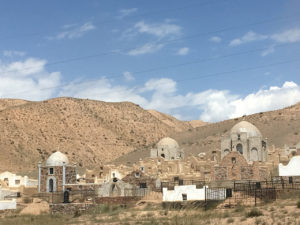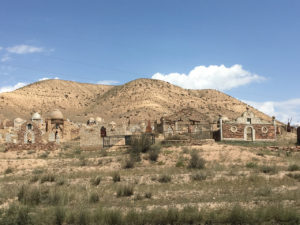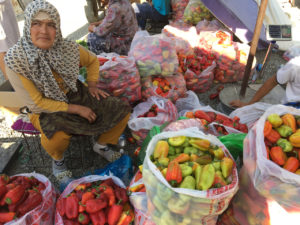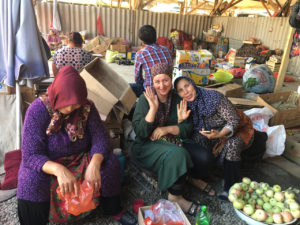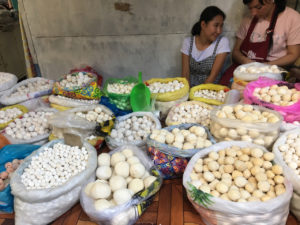Kyrgyzstan has some of the most consistently spectacular landscapes I have ever traveled through. Imagine a country with rugged snow-capped peaks like Switzerland, fjord-like waterways like Norway, alpine lakes like Northern Italy, and red rock formations like the canyon lands of the United States – that is the Kyrgyzstan we have passed through over the last few days. All of these heart-opening kinds of scenery can be found in other parts of the world but not all together and in so continuous a viewing of nature’s majesty as I have found here.
We spend the night in the small village of Kyrill Oy, off all beaten tracks with a very meagre store and a school. Everyone has chickens in their enclosed yards. We take a walk along its dirt road to a rushing river. Old men in traditional hats stop and ask me where I am from. Children play in the road. Women are watering their gardens, which all bloom with beautiful flowers.
The morning, we awake to lightening flashes and light drizzle which, when we are on the road once again, turns into violent hail and rain. The red clay roads become slippery mud as we wend upwards with sloping mountains on one side and a sharp drop off to raging white water bellow us on the other. We have an excellent driver and at least the roads are wide. We drove through great stretches of steppe, long rising areas of plain, with high mountain tops in the background playing with the rain clouds.
We end the day’s journey by a huge man-made lake which is the largest reservoir in the country made by damming the end of a long valley. It is truly beautiful, surrounded by the hills which were once the mountains around the valley, reflecting the blue sky when the sun finally came out today. Our old resort hotel is comfortable in very Soviet style — faucets are loose, electrical connections are shaky, pathways are cracked with weeds, nothing is well maintained and yet it is considered rather luxurious. By the shore, we swim with the other guests and we sit for our meals under an arbor of trees overlooking a magnificent view
Our journey in a sparsely populated land continues the next day as we travel past vast deep reservoirs formed by damming steep valleys in the Tien Shan mountain range. The minerals have turned this water a startling blue which changes color as we make hairpin turns and through 3 tunnels on the mountain highway.
We turn off onto a dirt road and check into a guesthouse next to a small rushing river, which is still a working farm. Young men are pitching hay into a barn for the winter and the chickens with their chicks are scratching in the dirt outside our room. The roosters wake me up in the morning. It is a simple place with 12 of us and two toilets and two showers (one inside and one outside), shoes taken off to go inside.
We then drive further on a narrow road lined with walnut trees, yellow crabapple and purple plum trees dripping fruit, and large masses of white hollyhock-like flowers, purple and yellow wildflowers to a Unesco-landmark park which encompasses a spectacular large lake. It is very deep blue and surrounded by craggy mountains of pine. We take turns on a boat trip, 4 of us at a time in a small motor boat. The boatman who is also a form of park ranger said he saw 14 brown bears this past spring and 2 snow leopards. We told him he works in one of the most beautiful places in the world.
It is also a place for local family gatherings and picnics with shaded individual platform decks arranged for a place for visitors to rest and play. There we listened to an accordion player sing traditional songs while our more local visitors sang along and invited us to participate. In a nearby hut, we watched women rolling out paper-thin layers of dough to form meat dumplings. I used my rudimentary Russian to talk to a man who turned out to be a driver for some of the visiting families, with 4 children and 5 grandchildren.
A note about garbage: the blight of plastic garbage is just beginning here. Fast food wrappers and plastic bags and bottles are scattered around areas which were undoubtedly pristine just a short while ago. I asked Nastya, our guide, who has also taught kindergarten, whether she teaches the children to use waste baskets and she says she does try. It is certainly not as bad as others places i have been but the culture is still accustomed to just throw things out the window or wherever they wish without concern for the environment.
At our guesthouse, we eat together outside, red tomato and cucumber salads (we all say that Kyrgyzstan must have some of the best tomatoes anywhere), soup and whereas others have meat dumplings, they make me a vegetarian version. I have brought with me two jars of nut butter but have not had to use them very often, usually for breakfast when eggs and milk are the main ingredients in the diet. My system has stayed strong and healthy where others have faltered and had problems along the way.
Our last day of travel is through mostly simple agricultural landscapes, fields of corn and cotton, men with wizened weather-brown faces pulling wood with donkeys, men and women with bandanas on their heat working in the fields, a few tractors here and there. We see what looks like a miniature city from a distance and then discover it is an ornate Muslim cemetery providing structures to honor the dead.
There is a sense of a peaceful farm-based economy where people don’t ask for, or get, very much material sustenance but rely on community for supporting their world.
Our last stop, Osh, is the second largest city of Kyrgyzstan but is really more of a big town, with a University and a few big buildings. At lunch, there is literally nothing for me to eat and the smell of roasting meat, shashlik, wafts everywhere. I dig out my Peanut Butter. Dinner, on the other hand, is at a log-cabin style outdoor restaurant, where I get a delicious eggplant and tomato salad with grilled vegetables and buckwheat kasha while others eat skewers of lamb, chicken, beef, rabbit and horse. And several people are sick the next day.
In Osh, we go to the oldest bazaar in Central Asia, a long covered area of small stalls selling assorted clothing and merchandise and an attacked area for food and vegetables, including piles of spices in wonderful smelling pyramids. Osh was a stop on the Silk Road, you can imagine the caravansaries here bringing in goods from the East and trading with those coming in from Turkey in the West.
Our last night in Kyrgyzstan as we cross over into Uzbekistan tomorrow. This has been a memorable immersion into a culture of the past, an agrarian way of life which has disappeared from most of the world, an environment spared for the moment from the excesses of a culture of consumption, with an overlay of the Soviet style imposed on it for so many years.

